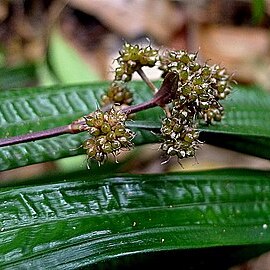Perennial herbs with short, rather stout rhizomes; long-creeping stolons absent (in Mal. spp). Flowering stems centrally arising from a tuft of normal leaves, erect, trigonous, usually leafy, or from the axils of the lower leaves or below the leaves and then scapiform. Leaves 3-ranked, basal and usually one to several higher on the stem, subcoriaceous or herbaceous, conduplicate at the base, very acute, with 3 more prominent nerves, linear to lanceolate; cauline leaves sheathing the stem, in the scapigerous species reduced to bladeless sheaths. Inflorescence terminal, paniculate, more or less corymbose, sometimes contracted into a single capituliform cluster. Bracts long, leaf-like, not sheathing at the base, in the scapigerous species small, almost glume-like. Spikelets few to very numerous, ovoid to oblong-ellipsoid, often almost globose when in fruit, terete, several-to many-flowered. Glumes membranous to chartaceous, spirally imbricate, glabrous, smooth, 1-nerved, muticous or with slightly excurrent midrib, some lower ones empty. Flowers hermaphrodite, strongly dorsiventrally compressed. Hypogynous scales 2, hyaline, transversal, opposite, boat-shaped, ciliate on the acute keel, often (always in Mal. spp.?) delicately connate on the adaxial side, but readily rupturing when the fruit develops (in some extra-Mal. spp. also connate on the abaxial side and then forming a tube); no inner flat scales present. Stamens 2, in the axils of the scales (in some extra-Mal. spp. stamens 3). Ovary terminal. Style continuous with the ovary, not or hardly incrassate at the base; stigmas 2, long. Nut biconvex, ovate, elliptic, or almost orbicular, hard, smooth or irregularly wrinkled, with long spongy beak confluent with the nut proper.
More
Herbs, perennial, moderately robust to robust, rhizomatous [or stoloniferous]. Roots coarse. Culms central or lateral, if lateral then with cataphylls at base. Leaves 3-ranked, basal or cauline, ligulate; basal leaf sheath folded, adaxially open, cauline leaf sheath tubular; leaf blade leathery, glabrous. Involucral bracts leaflike or glumelike, basal bract usually longest. Inflorescence usually an open compound panicle or capitate, with 1 to many spikes. Spikes comprising many spirally imbricate glumelike bracts each subtending a bisexual spikeletlike unit with a much reduced axis (pseudospikelet). Pseudospikelets comprising a naked apparently terminal female flower and 2(or 3) glumes all subtending a male flower comprising 1 stamen; basal 2 glumes opposite, keeled. Perianth bristles absent. Stigmas 2 or 3. Nutlet with a sculptured hard outer surface, apex often conically rostrate or sometimes mucronate.
Inflorescence a head, spike, or corymb; flowers with 2 or more stamens; scales 2 or more, 2 of them often connate; style 2-fid.

